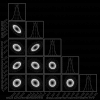J. Kissel, E. Goetz We've taken another DARMOLG TF and PCAL2 DARM transfer function in order to see if / how the SRC Detuning Optical (Anti-)Spring is changing from lock-stretch to lock-stretch. The bad (but not necessarily unexpected) news: it looks like the optical (anti-)spring frequency is moving around. One can tell by looking at the lowest frequency data points in the .pdf attachments. The model has a spring frequency of 9.381 Hz and both measurements are divided by it to form the residuals on the right column of subplots. Note also that Kiwamu and Craig's more sophisticated parametrization for the optical spring (which includes some Q between in the anti-spring poles, see LHO aLOG 28274) is not yet included. Jul 1 data points are ~ +15% discrepant in magnitude, where as Jul 09 data points are ~ +25%. More thoughts on this (what to do about it, how to track it, tests to try and control / reduce it) after the weekend. The pre-processed sensing function has been attached here, such that whomever gets to it first, can reproduce the fit using Craig's code from LHO aLOG 28274. Data sets live here: ${CalSVN}/trunk/Runs/PreER9/H1/Measurements/DARMOLGTFs/2016-07-09_H1_DARM_OLGTF_4to1200Hz_SRCTuned.xml ${CalSVN}/trunk/Runs/PreER9/H1/Measurements/PCAL/2016-07-09_H1_PCAL2DARMTF_4to1200Hz_SRCTuned.xml
C. Cahillane, K. Izumi See DCC T1600278 for an updated document on the sensing function detuning. I've taken the new ER9 sensing measurement from July 9th and plotted it next to the July 1st measurement for comparison, and done a fit on the July 9th measurement as well. Plot 1 shows July 9th and July 1st Sensing measurements at LHO. The detuning is visibly different for both measurements. Plot2 shows the July 9th fit. The fitting parameters are copied below. Plot 3 shows the fitting parameter cornerplot.July 9st Parameters ===================== Optical gain = 8.998599e+05 +/- 1.095765e+03 [cnts/m] Cavity pole = 3.206019e+02 +/- 8.580968e-01 [Hz] Time delay = 2.218270e+01 +/- 5.364895e-01 [usec] Spring frequency = 8.304667e+00 +/- 6.061604e-02 [Hz] Spring Inverse Q = 5.107011e-02 +/- 6.784018e-03The original July 1st parameter fits from aLOG 28274 are reprinted here for convenience:July 1st Parameters ===================== Optical gain = 9.124805e+05 +/- 8.152381e+02 [cnts/m] Cavity pole = 3.234361e+02 +/- 5.545748e-01 [Hz] Time delay = 5.460838e+00 +/- 3.475198e-01 [usec] Spring frequency = 9.975837e+00 +/- 5.477828e-02 [Hz] Spring Inverse Q = 1.369124e-01 +/- 3.522990e-03There is a difference of 1.67 Hz in the optical spring frequency. This represents a detuning phase difference of 0.316 degrees:July 1st Detuning Phase = 1.027 deg July 7th Detuning Phase = 0.711 deg
TF from DCPD sum to DARM IN1 at 2016-07-09 01:00:00 is 2.96e-7 ct/mA. Therefore, the peak optical gain (above the antispring, below the DARM pole) is 3.0 mA/pm for this lock stretch.
During O1, the peak optical gain was 3.2 mA/pm. However, this was for 95 kW of circulating power and 20 mA of dc readout photocurrent. For ER9, these numbers are instead 130 kW and 15 mA. Therefore, the naive expectation for the ER9 optical gain would be 3.2*sqrt(130/95)*sqrt(15/20) = 3.2 mA/pm, rather than the 3.0 mA/pm that was observed.
In terms of DARM shot noise, 3.2 mA/pm with 20 mA of dc photocurrent (the O1 situation) amounts to a shot noise of 2.5e-20 m/rtHz in the bucket. 3.0 mA/pm of with 15 mA of dc photocurrent (the ER9 situation) amounts to a shot noise of 2.3e-20 m/rtHz in the bucket; i.e., an improvement of less than 10 % over O1. This agrees roughly with Kiwamu's shot noise analysis.






